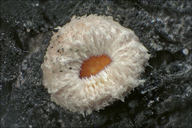|
|
click photo for larger file

Lachnellula occidentalis
|
Photographer: Dr. Amadej Trnkoczy
ID: 0000 0000 0114 3050 (2014-01-30)Copyright © 2014 Dr. Amadej Trnkoczy
|
|
INFORMATION PROVIDED WITH THE PHOTO
|
date of photo Dec 31, 2013
latitude 46.36021 longitude 13.70220
View on Google Maps.
location
Lower Trenta valley, near 'Na Melu' place, between villages Soča and Trenta, East Julian Alps (Posočje, Slovenia)notes Habitat: alpine valley, mixed forest edge, dominant Fagus sylvatica, Picea abies, Ostrya carprinifolia, Larix decidua, Fraxinus ornus, Fraxinus excelsior, Corylus avellana; modestly southeast inclined mountain slope, calcareous ground (overgrown old scree, rocks and boulders), limestone bedrock, relatively dry and warm place, partly sunny, exposed to direct rain, average precipitations ~ 3.000 mm/year, average temperature 7-9 deg C, elevation 600 m (1.950 feet), alpine phytogeographical region. - Substratum: dead, thin branches of Larix decidua still attached to the tree. - Comments: Several fruit bodies on several branches were found. The determination seems to me quite certain in spite of the fact that there exists many species in genus. L. occidentalis has relatively large spores, which, together with the substratum, much reduces number of options. The only eventual alternative seems to be Lachnellula willcommii. However it has broader spores (8-10 microns) and it is usually associated with Larix decidua cankers. All observed fruitbodies, except one (Figs. 9. and 10.), seem to grow on normal not deformed branches. - Spores smooth. Dimensions: (16.4) 17.8 - 21.8 (24.6) x (4.8) 6 - 7.9 (9.1) microns, Q = (2.2) 2.4 - 3.4 (3.7) ; N = 31; Me = 20 x 7 microns ; Qe = 2.9. Olympus CH20, NEA 100x/1.25, magnification 1.000 x, oil, in water. AmScope MA500 digital camera. Fruit body close up: Novex Trinocular. - Herbarium: Mycotheca and lichen herbarium (LJU-Li) of Slovenian Forestry Institute, Večna pot 2, Ljubljana, Index Herbariorum LJF - References and cited spore dimensions: (1) http://linnet.geog.ubc.ca/Atlas/Atlas.aspx?sciname=Lachnellula%20occidentalis 12-17 x 3.5-6 microns (2) http://nt.ars- grin.gov/taxadescriptions/factsheets/pdfPrintFile.cfm?thisApp=Lachnellulawillkommii 5-8.5 um wide (3) Dichotomous key to Lachnellula (worldwide), (Trichoscyphelloideae, Lachnaceae, Helotiales, Ascomycetes), with a synoptic table of characters (H.O. Baral, Feb. 2000, with updates until 2008, unpublished) available at 'In vivo veritas' Baral 14(16-22)24/7-8(9,5) (4) http://www.ascofrance.com/forum/21908/lachnellula-on-larix 16.3-20.8 X 5.6-7.1 (5) http://www.natur-in-nrw.de/HTML/Pilze/Ascomycota/PAS-175.html (13) 17-20 (24) x 5-8 µm, (6) J. Breitenbach, F. Kraenzlin, Eds., Fungi of Switzerland, Vol.xx. Verlag Mykologia (1984), p 196. 12-17/3,5-6. (7) L. Hanse and H. Knudsen, Nordic Macromycetes cited in Ref.: (4) 18-20 X 7-9 µmcamera NOVEX Trinocular
contributor's ID # Bot_778/2013_DSC9552 photo category: Fungi - fungi
|
MORE INFORMATION ABOUT THIS FUNGUS
|
| View all photos in CalPhotos of Lachnellula occidentalis Check Google Images for Lachnellula occidentalis |
|
The photographer's identification Lachnellula occidentalis has not been reviewed. Click here to review or comment on the identification. |
|
Using this photo The thumbnail photo (128x192 pixels) on this page may be freely used for personal or academic purposes without prior permission under the Fair Use provisions of US copyright law as long as the photo is clearly credited with © 2014 Dr. Amadej Trnkoczy.
For other uses, or if you have questions, contact Dr. Amadej Trnkoczy amadej.trnkoczy[AT]siol.net. (Replace the [AT] with the @ symbol before sending an email.) |
|
|
